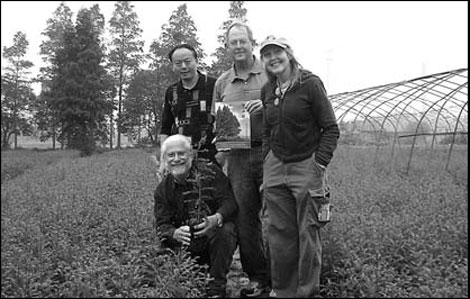'Happy Tree' lures Texan to China
Updated: 2011-10-03 07:35
By Mike Peters (China Daily)
|
|||||||||
|
Clockwise from bottom left: US blueberry grower Henry Sunda, Nanjing Botanical Garden professor Yin Yunlong, and US horticulturist David Creech and his wife, Janet, survey a Taxodium nursery near Jinjiang, Fujian province, which has more than 2 million plants. Provided to China Daily |
David Creech is a self-proclaimed "plant nut" from Texas who keeps coming back to China for two reasons.
The horticulture professor and arboretum director wants to help stop the spread of cancer around the world. He'd also like to help spread blueberry farms around China.
More than a decade ago, cancer research labs and pharmaceutical companies in the US couldn't get their hands on enough Camptotheca acuminata, also known as Happy Tree of China thanks to the literal translation of its name, xi shu. The tree is the source of Camptothecin, a cancer-fighting drug.
Creech knew there were more plants - and likely more genetic variety - in the tree's native regions, that is, primarily Southeast China and the Tibet autonomous region.
"My first trip to China was in 1997 when I accompanied Shiyou Li, the director of the National Center for Pharmaceutical Crops at Stephen F. Austin State University in Nacogdoches, Texas. Li had received a large grant for Camptotheca acuminata," Creech says. "We traveled all over China for about six weeks working with Chinese officials to accumulate germplasm from a wide cross-section of provenances and to study the ethnobotanical aspects of the tree.
It was the start of a long relationship.
"During that first visit," he says, "I met many Chinese scientists and made friends with like-minded horticulturists. Those first encounters led to later invitations to visit China on a variety of projects. "Since that time, I've been to China about a dozen times," he says, and he's always surprised at what he sees.
"I have been totally amazed at the urban vegetation strategy in China. There's no doubt China is a world leader in re-vegetation and highway plantings. Any visitor to China - particularly those who visit the megacities - cannot help but notice that China is planting millions of trees. All the superhighways, highways, roads, railroads, canals and riversides are planted with trees".
Besides providing an aesthetic treasure, he says, "these trees do much to provide a carbon sink, alleviate pollution and reduce erosion".
"I also come back to China because I'm enthralled with Taxodium improvement," Creech says, referring to a plant genus in the cypress family. "While baldcypress is a native US tree, we have done very little to improve the species. Chinese researchers have bred promising parents, selected superior clones, and propagated them asexually into numbers that we in the US find difficult to comprehend.
"A couple of years ago I visited a Taxodium nursery near Jinjiang (Fujian province) that has over 2 million plants," he says. "That's probably more than is produced in all the United States."
Creech's counterpart, Yin Yunlong, a professor at the Nanjing Botanical Garden (NBG), has introduced him to the extensive breeding and selection efforts that his garden has pioneered in China and the extension of this US tree into highway plantings, parks, and coastal windbreaks. Some of that is documented on the website of Creech's university arboretum, http://arboretum.sfasu.edu.
Creech is also eager to see China embrace another US favorite: blueberries. "I'm excited that the growing blueberry industry will prosper and provide China with a new and exciting highly nutritious crop," he says. "With significant central and provincial support, many plantings are in the young stages of development. Whether or not they prosper will depend on Chinese scientists, farmers and businessmen. I'm here to help."
Creech is working with professors He Shanan and Yu Hong, also of the NBG, on blueberry research. "It's a new and exciting crop for China," he says. "Blueberries have gained favor with the upwardly mobile Chinese looking for a tasty and highly antioxidant fruit. Thousands of acres are being planted and some have met with great success. The market is under-exploited, and there appears to be great excitement and government support to extend plantings across those areas where this fruit crop has been adapted."
China Daily
(China Daily 10/03/2011 page5)











